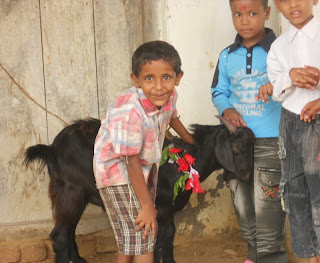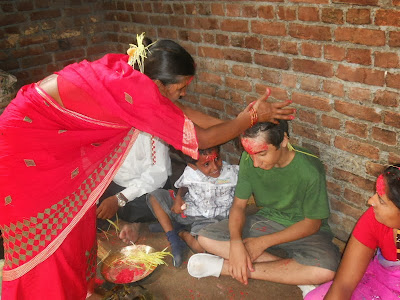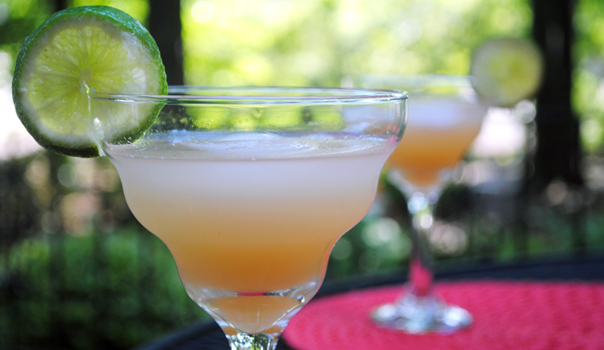 Ah, Dashain. A time for kids, goats and goddesses. And photos, of course. Particularly when we go to our in-laws' village, where I get to pretend I work for National Geographic.
Ah, Dashain. A time for kids, goats and goddesses. And photos, of course. Particularly when we go to our in-laws' village, where I get to pretend I work for National Geographic.But ... well ... one of the cool things about village life is that it's rustic, and rustic means "not so much electricity," which is richly atmospheric and good for the soul but not so good for camera batteries. (Oh, our village has electricity. It came about 10 years ago. That doesn't mean it's around when needed. Much, come to think of it, like Kathmandu.)
As a result, when the streets filled with indigenous Tharu girls with ceremonial vessels on their heads and people chanting and throwing colored powder as they pulled a larger-than-life statue of the goddess Durga through rain-soaked lanes, my camera died. I bet that doesn't happen at National Geographic.
So you'll have to take my word for it that Dashain came to a splashing end with a wild flash-mob wiggling snake line as hundreds of people did a barefoot dervish squish-dance in the mud all the way to the river, where the Goddess was worshipped with incense and song by Tharu women and I felt the ancient power of Woman's Spirit in Creating Civilization from Chaos before a batch of men dragged her into the water and floated her away. Glub. I'm trying to figure out the significance of this.
Yet, sadly, I can't show it, or the moment when my teenager's feet got sucked into the quicksand-like mud on the riverbank and he stood there flailing while Durga was towed past him by a chanting mob, or a few minutes later when I got my karmic comeuppance for laughing at his predicament and I got stuck too, but actually IN the river, and those girls above with the pots enjoyed themselves as I tried to pull out of the sucking flooping muck that had suddenly become like a pair of cement shoes courtesy of Tony Soprano, so ya tried to cross us didja, well go sing with the fishes, all without toppling into the water (which is not good when you're wearing cement shoes) ...
Come to think of it, that might not have been the best place for a camera anyway.

But I'll make up for it with other pictures. Like this one, which was the absolute best Durga I found. I swear she's giving the demon a spanking. Dude, do not cross the primordial mother. Even when she's stuck in the mud.
Of course, the Goddesses all end up in the muddy river afterwards, at least (see Multicultural Disclaimer from previous post) among certain groups in our particular area of Nepal. The holy immersing (permanently) of thousands upon thousands of Durgas with their weaponry, lions, buffaloes and vanquished demons can be problematic for the environment, as reported here (from Patna) and here (from Hyderabad) and here (from West Bengal) by journalists who work harder than me.
Also a submerged Warrior Goddess Durga surfaced like a U-Boat while my son was swimming in a lake the next day and nearly torpedoed him. Remember, guys, she's a warrior goddess. She will return. Watch out if you go in the water right now. It's Jaws Meets the Spanish Inquisition out there. Cue Monty Python: "No one expects the Goddess Durga!"
The camera did work some of the time, though. And since holidays are a great time for kids, and these are such cute kids, here's a photo roundup. With, of course, educational context in case anyone who stumbled onto this blog needs it for a middle-school report. (Just remember the proper citation: "Too Lazy for Yoga." That will impress your teacher.)
So here comes ...
The (Educational) Cute Kid Photo Show!
The girl above lives in a beautiful house covered with folk art in the Tharu village, home of the enthusiastic goddess dunkers, who are also the indigenous people of the area. (Traditionally forest dwellers of ancient and uncertain origin, they made good subjects for real NatGeo photographer Eric Valli). It's the largest village around by population and is about a 5-minute walk through rice fields from my family's village, which is heavily pahadia (Nepali hill people).
Tharu speak a different language, but almost everyone in the area, from my old in-laws to the children, are multilingual in Nepali, Tharu and Awadhi (plus Bollywood Hindi and soap-opera Urdu.) This little girl below, also Tharu, is wearing a protective amulet around her neck. Either that or it's her secret language decoder ring.
The girls below live in my family's village, in a neighborhood called Kami Tol, whose residents belong to the blacksmith (Kami) caste. They're Dalit, the umbrella term for people known to Westerners as "Untouchables," and traditionally practiced occupational skills such as metalwork, tanning, tailoring and butchering. Labeling those skills as "low status" was probably not the best strategy for technological development over the centuries, but that's another issue in a complicated topic. They're Nepali-speaking pahadia (hill people) and are basically indistinguishable, physically and culturally, from other pahadia. The clue is the last name: If you're Dalit, your last name might be Kami, Sarki, Bishwokarma, Pariyar, or ironically, Nepali. If your last name is Smith, Cobbler or Taylor, join the ranks. Well, technically, all foreigners qualify. Sorry.
 |
| Hey, look. Five cute kids! Count them. |
Dalit life has improved greatly in the last decades. In fact, the village's private English school is operated by a Dalit couple, so high-status kids go to a Dalit-run school. There's widespread recognition now that untouchability isn't an integral part of Hinduism, didn't exist in earliest times, and isn't exactly fair or just. Still, if you're born Dalit, you're a whole lot like likelier to be poor, with an illiterate family and fewer opportunities, and to face prejudice from the ignorant. (Who ought to try living without butchers and tailors sometime.) But as I said, it's a complicated topic. This girl and her friends are not starving or destitute, they live in a village that has changed enormously for the good, and she has a kid goat that she thinks is really cool and needs its photo taken many times. Many many times. With as many friends as possible. Maybe that explains my dead camera battery.
I WANT THESE SHIRTS. Hew of Fashion! Free Mi! GEDEOPEED! Someday everyone will speak good English, and then they won't have shirts like this, and it will be a terrible loss to the landscape. I mean, Nepal isn't all mountains and lush scenery. If we didn't have humor around here, it could be a bit hard to take. So huzzah for the ridiculous shirts.
In the Dressed For The Holidays category, we have this Dashain Beauty,
my chic niece-type relative (it's complicated),
who shows the fashionable way to put barley sprouts in your hair.
The well-dressed forehead will wear yogurt, rice and vermilion powder this season.
You're never too young for a Dashain blessing. The cap keeps the barley sprouts on,
and the rain off. (We got hit by fringe-of-the-Indian-typhoon rain.)
Aspirational dressing. He doesn't actually have a Facebook page. But yes, he knows what it is.
And these Tharu boys do know Gangnam Style.
Which, incidentally, may be one of the coolest videos ever. Think about it. It's a humorous video about the values and norms of Seoul's version of Beverly Hills. It's Valley Girl for South Koreans. A local in-joke about Asian Chic. How obscure can you get?
Yet it beat Justin Bieber for Most Watched Video Ever (1.7 billion views and counting), and now here it is in a village in the middle of nowhere. Not Michael Jackson or Britney Spears or someone rapping about bling, but a dweeby guy from Korea riffing on trying to be cool. Humor about bling and schlock beats bling and schlock. An Everyman from the non-Western sticks beats the Hollywood machine.
Gosh, it's just like Rocky. It could be a movie. With action figures! And more t-shirts.
And then, of course, there's this classic look. Courtesy of my nephew. Very Calvinesque (of Hobbes, not Puritanism). Somehow it never grows old.
Oh wait. Yes it does.
Which, of course, brings us back to this ...













































